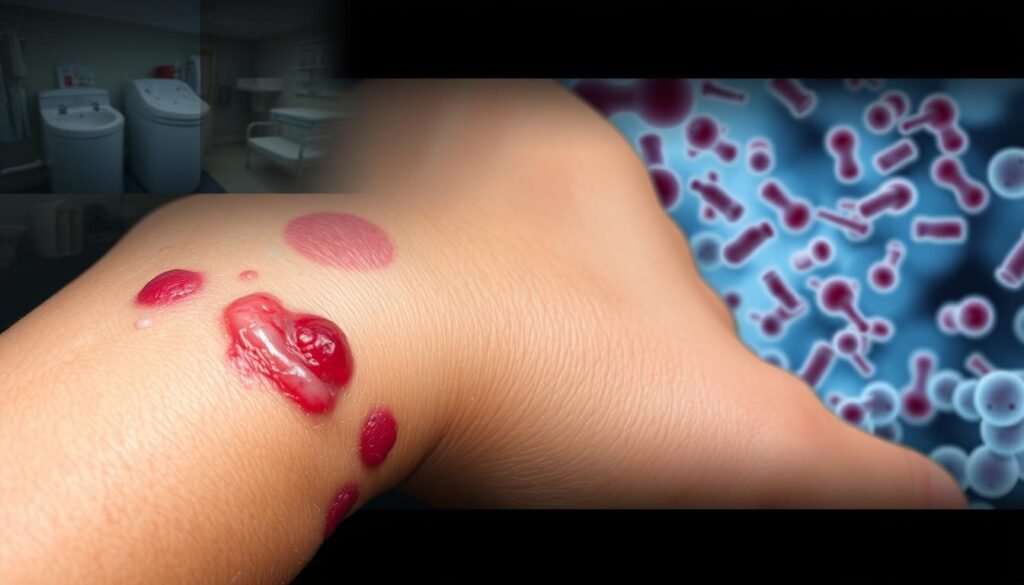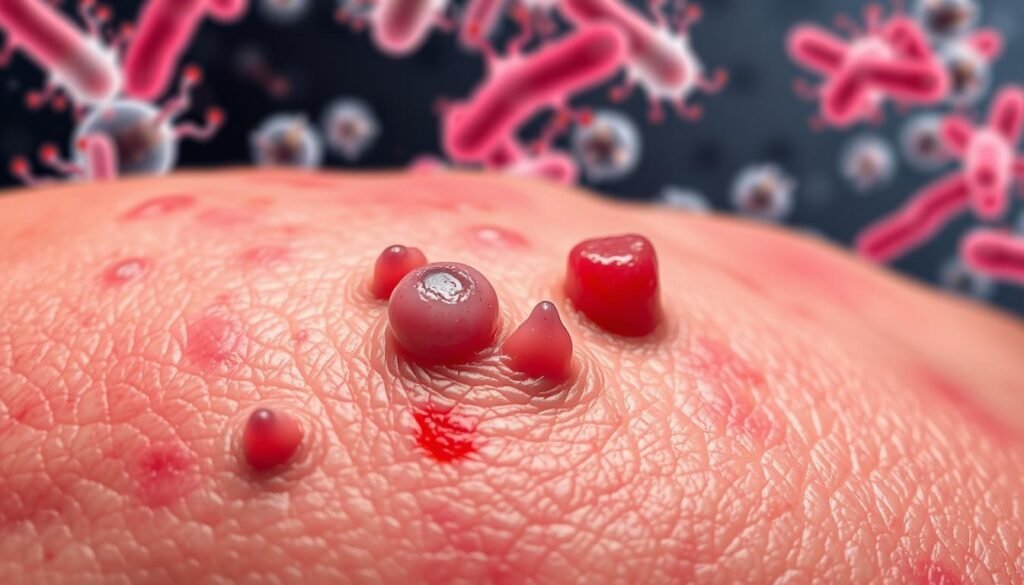Did you know that up to 30% of people with long-term skin problems might get folliculitis? This can happen more often with conditions like eczema or acne. And it gets trickier when it’s caused by MRSA. That’s a type of bacteria that’s tough to fight with regular antibiotics. As these hard-to-beat bacteria become more common, it’s crucial to know the symptoms, causes, and ways to treat them. This article will help you understand MRSA folliculitis better. It will give you the info you need to spot and deal with this stubborn infection quickly. For extra help on spotting folliculitis symptoms, check out this link.
Key Takeaways
- Approximately 30% of those with chronic skin conditions may experience MRSA folliculitis.
- Early identification of symptoms is crucial for effective MRSA treatment.
- Skin infections like MRSA folliculitis can lead to severe complications if untreated.
- Awareness of risk factors, such as diabetes and immunocompromised conditions, can help in prevention.
- Understanding the different treatment options for MRSA folliculitis is essential for successful management.
Understanding Folliculitis
Folliculitis is a skin issue where hair follicles get inflamed and infected. It shows up as small bumps or pimples on hairy parts of the body. There are many folliculitis causes, like bacteria, fungi, or viruses. Each cause requires a different folliculitis treatment. Treatments make a big difference in a person’s life.
Figuring out what causes folliculitis is key. It’s especially important for people with weaker immune systems. They could face serious problems from this condition. Bacteria named Staphylococcus aureus is a common cause.
Keeping clean helps stop folliculitis from spreading. For those looking to avoid this issue, there’s advice available. Check out how to protect yourself in this article.
| Type of Folliculitis | Cause | Treatment | Characteristics |
|---|---|---|---|
| Bacterial Folliculitis | Staphylococcus aureus | Topical antibiotics (e.g., mupirocin) | Pustules, itchy skin |
| Fungal Folliculitis | Malassezia | Systemic antifungals (e.g., itraconazole) | Often appears in hot, humid conditions |
| Gram-negative Folliculitis | Heat and moisture exposure | Oral antibiotics (e.g., ciprofloxacin) | Usually linked to hot tub use |
| Viral Folliculitis | Herpes simplex virus | Oral acyclovir | Blister-like lesions |
There are many types of folliculitis, and each has its own features. Knowing these can help people find the right folliculitis treatment. Taking care of these causes and symptoms can improve skin health and prevent worse problems.
What is MRSA Folliculitis?
MRSA folliculitis is an infection in the hair follicles. It’s caused by a tough kind of bacteria resistant to many antibiotics. This infection looks like painful, swollen spots around hair follicles at first. It’s not like other staph infections because it doesn’t respond well to usual antibiotics, making it hard to treat.
People with weak immune systems are more likely to get MRSA folliculitis. This includes people with HIV or those taking drugs that lower their immune response. If not treated, it can cause bigger health problems. It might lead to abscesses or even sepsis, a life-threatening reaction to infection.
It’s critical to spot MRSA folliculitis early. Symptoms usually get worse in three to four days, causing a lot of inflammation. This folliculitis isn’t easy to get rid of and might need strong oral antibiotics or other treatments.
Knowing about MRSA folliculitis is the first step to getting better. Fast treatment helps stop more serious problems with this stubborn staph infection.
Symptoms of MRSA Folliculitis
Knowing the signs of MRSA folliculitis is key to getting help fast. This skin problem has unique signs that make it different from other skin issues. By understanding MRSA symptoms, people can get the right medical help and avoid worse problems.
Common Signs and Symptoms
The main signs of MRSA folliculitis often are:
- Pustules, or pus-filled bumps
- Red, inflamed papules, which are small solid bumps
- Clusters of lesions that can show up in shaved areas, like the beard or thighs
- Itching or soreness in those spots
- In worse cases, the lesions can hurt and leak pus
These folliculitis symptoms can appear on different parts of the body. It’s vital to watch any spots that don’t get better after three or four days. This could mean the infection is getting worse.
Comparison with Other Forms of Folliculitis
MRSA folliculitis is a bit like other folliculitis forms, especially the ones caused by a milder bacteria. The major difference is in how bad they can get and the chance of them coming back. Even though both can look like staph infection symptoms, MRSA is usually more severe and more likely to recur.
In short, telling bacterial folliculitis types apart by comparing symptoms can help choose the best treatment. This leads to better care for patients and improved health.
| Symptoms | MRSA Folliculitis | Other Folliculitis Forms |
|---|---|---|
| Pustules | Common | Less common |
| Red, inflamed bumps | Common | Common |
| Clustering of lesions | Frequent | Occasional |
| Itching and tenderness | Moderate to severe | Mild |
| Pain and drainage | Common in severe cases | Rare |
Causes of MRSA Folliculitis
MRSA folliculitis comes from a bacteria called Methicillin-Resistant Staphylococcus Aureus. This bacteria lives on our skin. It causes infections in hair follicles if there’s a cut or scrape. Knowing about MRSA causes helps in stopping and treating it.
Some things make MRSA infections more likely. Broken skin, not keeping clean, and being close to sick people can increase your risk. Places like gyms or dorms, where people touch a lot, also raise the risk of catching MRSA.
Staphylococcus aureus bacteria often cause skin infections worldwide. Community-acquired Methicillin-Resistant Staphylococcus Aureus (CA-MRSA) leads to many of these infections. This is especially true in hot, moist places that make folliculitis more likely.

Athletes who play contact sports face a high risk, with MRSA skin infections reported between 5% to 10%. College dorms can see quick spreading of the bacteria. Some studies show a 31% chance of catching MRSA in such close quarters.
| Factor | Description |
|---|---|
| Skin Integrity | Breaks in the skin increase vulnerability to MRSA entry. |
| Hygiene | Poor hygiene practices can facilitate bacterial infections. |
| Environment | Warm, humid areas elevate the risk of developing folliculitis. |
| Contact Sports | Athletes are at higher risk due to frequent skin contact. |
| Shared Spaces | Common environments like gyms and dorms promote rapid transmission. |
It’s vital to understand the multiple factors that lead to MRSA folliculitis. This knowledge helps in preventing it. It also aids in getting quick help when infections happen.
Risk Factors for MRSA Infections
It’s very important to know what increases the chance of getting MRSA infections. If you have certain health issues, your risk goes up. This is especially true for people with diabetes and those who have weak immune systems.
These conditions make it easier to get infections on the skin.
Diabetes and MRSA
People with diabetes are more at risk for MRSA infections. They often have blood flow problems that can hurt their skin’s health. This can weaken their ability to fight off germs.
Because of this, they might get MRSA infections on their skin more easily. If you have diabetes, taking good care of your skin and watching for infection signs is key.
Immunocompromised Conditions
People with weaker immune systems need to be careful about MRSA. This includes those on chemotherapy or living with HIV. Their bodies struggle more to fight off infections, including MRSA.
This makes it very important for them to take steps to avoid skin problems from MRSA.
| Condition | Risk Level | Comments |
|---|---|---|
| Diabetes | High | Compromised skin and immune system increase infection likelihood. |
| HIV/AIDS | Very High | Severe impact on immune response, increasing MRSA infection chances. |
| Cancer Treatments | High | Chemotherapy can impair immune defenses, facilitating MRSA infections. |
| Organ Transplant | Very High | Immunosuppressive medications create a fertile ground for infections. |
Methicillin-Resistant Staphylococcus Aureus (MRSA) Explained
MRSA stands for Methicillin-Resistant Staphylococcus aureus. It’s a type of bacteria that resists many antibiotics. MRSA explained tells us about the serious issues caused by such superbugs. Knowing how MRSA is different from other staph infections helps in treating it right.
How MRSA Differs from Other Staph Infections
MRSA and other staph infections start the same but MRSA fights off some antibiotics. This mainly happens due to antibiotics being used too much. Around 30% of people carry Staphylococcus aureus in their noses. Yet, only 2% have MRSA. People who inject drugs face a higher risk, 16 times more likely to get an infection.
Prevalence of MRSA in Folliculitis Cases
MRSA prevalence is high in folliculitis cases, which show up as red, swollen spots with pus. The rate of MRSA in hospitals jumped from 2% in 1974 to 64% in 2004. The growth of MRSA cases in communities since the 1990s shows it’s hard to control. Spotting these patterns helps in fighting bacterial infections better.

Diagnosis of MRSA Folliculitis
Healthcare professionals start diagnosing MRSA folliculitis with a detailed folliculitis evaluation.
They look for signs like pustules and redness. Knowing the main symptoms is key as they look like other skin issues.
To confirm a skin infection diagnosis, doctors may need to take swab cultures. This tells them which bacteria are causing the infection. It’s crucial to know this to pick the right treatment.
Finding out if it’s MRSA early is important for choosing the best treatment. It also stops the infection from spreading. Quick diagnosis helps avoid worse problems later on.
Washing hands often with antibacterial soap is a good way to prevent MRSA. This is extra important in places like schools. If you know the signs of MRSA, you can get help before it gets worse.
MRSA Folliculitis Treatment Options
Treating MRSA folliculitis means using a mix of approaches. It depends on how serious and spread out the infection is. The main step is to start with topical antibiotics. These can handle milder cases by targeting the infection directly. If the infection is more widespread, doctors might suggest oral MRSA antibiotics for a more complete treatment. There are also alternative treatments for those looking for a full range of options against the skin infection.
Topical Treatments
Topical antibiotics are key in fighting bacterial folliculitis. Doctors often recommend:
- Mupirocin: It’s very good against MRSA folliculitis, working about 90% of the time.
- Clindamycin: This is another go-to option. It’s great because it targets the bacteria directly and helps avoid drug resistance.
These treatments are usually the first step, especially in straightforward cases.
Oral Antibiotics
If creams don’t work or the infection is bad, oral antibiotics might be needed. Doctors commonly give:
- Cephalexin: You take 500 mg two times a day.
- Trimethoprim-sulfamethoxazole: This mix is good against tough bacteria.
- Dicloxacillin: It’s a strong choice for fighting various MRSA infections.
Following the doctor’s orders closely helps stop bacteria from becoming resistant.
Alternate Therapies
Some people look at complementary therapies too. Options include:
- Antiseptic washes: Using something like chlorhexidine can cut down on bacteria on your skin. This helps your main treatment work better.
- Laser treatments: They can sometimes cause folliculitis, but they can also ease ongoing skin problems.
Each choice adds to the wide range of treatments for MRSA. Treatments can be tailored for what each person needs.

| Treatment Type | Examples | Efficacy |
|---|---|---|
| Topical Antibiotics | Mupirocin, Clindamycin | ~90% |
| Oral Antibiotics | Cephalexin, Dicloxacillin | Good effectiveness if followed |
| Alternate Therapies | Chlorhexidine wash, Laser treatments | Varied success, consult physician |
Self-Care Recommendations for Folliculitis
Good self-care is vital in handling MRSA folliculitis. Right hygiene and shaving habits can lower the skin infection risk. These actions not only keep the skin healthy but also help in preventing infections.
Hygiene Practices
It’s crucial to keep clean to avoid folliculitis. Here’s what you can do:
- Use antibacterial soaps to cleanse affected areas.
- Launder personal items, such as towels and bed linens, regularly.
- Avoid sharing towels or clothing to minimize bacterial exposure.
- Wash the skin with mild soap twice daily to reduce the likelihood of infections.
Such steps are key for those with skin conditions like folliculitis. They greatly lower the risk of more severe issues.
Shaving Techniques
Shaving the wrong way can make folliculitis worse. But the right methods can prevent it:
- Use electric razors instead of manual razors to lessen skin irritation.
- Shave in the direction of hair growth rather than against it.
- Avoid shaving over irritated or inflamed skin to prevent further aggravation.
Following these shaving tips as part of skin care helps avoid folliculitis. It leads to healthier skin.
| Hygiene Practices | Shaving Techniques |
|---|---|
| Use antibacterial soaps | Shave in the direction of hair growth |
| Launder personal items regularly | Avoid shaving over irritated skin |
| Wash skin with mild soap twice daily | Consider using electric razors |
| Avoid shared towels or clothing | Keep blades clean and sharp |
Preventing MRSA Folliculitis
To prevent MRSA folliculitis, we should focus on stopping skin infections and understanding the risks. Simple steps can really help cut down the chances of getting an infection. It’s vital to treat and look after any skin injuries, as germs can enter through cuts.
Keeping away from people with MRSA helps stop the disease from spreading. In places like gyms and schools, it’s crucial to keep clean to fight off MRSA.
Cleaning yourself regularly is key to prevention. Washing hands often with soap that kills bacteria and not sharing things like towels or shavers are good habits. When you have a cut, covering it well stops germs from getting in. This is even more important for people who are more likely to get sick.
Here is a table that shows some great ways to stop MRSA folliculitis:
| Prevention Method | Description |
|---|---|
| Hand Hygiene | Wash hands regularly with soap or use alcohol-based hand sanitizer, reducing pathogen spread. |
| Wound Care | Promptly clean and cover any cuts or abrasions to prevent infection. |
| Avoid Sharing Items | Refrain from sharing personal items like razors, towels, or athletic gear. |
| Awareness in Communal Spaces | Be cautious in crowded areas and communal facilities, ensuring personal hygiene. |
| Regular Monitoring | Keep an eye on any signs of infection and seek medical advice when needed. |
In the U.S., there are more than 14 million doctor visits each year because of Staphylococcus aureus infections. This shows why stopping these infections is so important. To learn more about MRSA and skin infections, check out this resource here.
Following these steps helps make places safer and lowers the chance of getting MRSA folliculitis. It also helps keep our skin healthy.
Living with MRSA Folliculitis
Living with MRSA can be tough, especially if you get skin infections over and over. It’s key to know about these infections for dealing with MRSA well. Taking care of your skin by cleaning and moisturizing regularly helps a lot. These steps make your skin healthier and ease symptoms.
Seeing your doctor often is crucial for staying healthy and keeping skin infections in check. These visits help to see if treatments are working, if any meds need changing, and to keep up good cleanliness. Having a solid care plan helps people with MRSA feel in charge of their health.
Having support from loved ones makes fighting MRSA’s challenges easier. Talking openly about MRSA can make it less scary and push others to prevent it. A caring circle of friends and family makes those with MRSA folliculitis feel less alone, helping them handle the situation better.
For more on handling these infections, check out guidelines on MRSA treatment and prevention. This guide is full of helpful tips for anyone dealing with MRSA folliculitis. It shows how knowing how to take care of yourself is important for managing it long-term.
Conclusion
MRSA folliculitis is a serious skin problem that requires both awareness and smart handling. About 20% of people carry Staphylococcus aureus for a long time. Knowing about MRSA folliculitis is key because each year, about 500,000 US hospital patients fight staph infections.
This highlights the need for good treatment and ways to stop the infection from spreading. Understanding its symptoms, causes, and risk factors helps people spot the infection early. This knowledge leads to getting the right treatment sooner.
Since the 1960s, MRSA has grown to be a top reason for skin and soft tissue infections in the US. Teaching people about how to take care of their skin can greatly lower MRSA folliculitis’s impact.
As antibiotics work less against MRSA, it’s crucial for healthcare to focus on battling this infection. Training doctors and informing the public on how to handle this infection is a must. This leads to better health and lessens complications from this tough skin problem.
Knowledge is power when it comes to dealing with MRSA folliculitis. It brings the power to improve how we manage it and helps build healthier communities.
